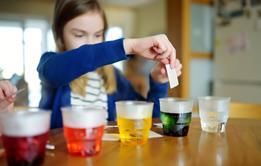What’s healthier than scientific curiosity? This spinach experiment, of course! Yummy and educational, learn about oxalic acid with this activity
In this video, education coordinator Joanna demonstrates why chewing spinach might leave your mouth and teeth feeling a little gritty. Some people say they feel a chalky texture when they chew spinach. So what causes this? And is eating spinach bad for us? This simple activity can be set for learners to try at home with a responsible adult or used as a classroom experiment.
Equipment list
- A bag of fresh spinach
- Yourself (and others in your household) to try this out on
Health and safety
- If you or your immediate family have ever suffered from kidney stones, it’s not recommended you try this experiment, even with the small amount you will consume.
- Ensure you wash your spinach before eating it.
Activity instructions
- Open the bag of fresh spinach and pop a few leaves in your mouth.
- Make sure you chew it well for at least 10 seconds. Can you detect a strange sensation in your mouth and on your teeth? If not, try some more!
Explanation
Oxalic acid is found in a variety of different foods including green leafy vegetables, nuts, seeds, most berries and soy products. Spinach contains very high levels of oxalic acid; it contains about 750 milligrams per 100 gram serving. The oxalic acid in spinach is confined within little pockets in the cell walls but when these are ruptured by either being boiled or being chewed, the cell walls break and oxalic acid crystals leak out.
Spinach contains calcium, as does your saliva. This combines with the oxalic acid crystals in the spinach’s cell walls and deposits calcium oxalate-rich plaque on your teeth. Being insoluble, you feel this as a chalky deposit in your mouth.
In large amounts, oxalic acid is poisonous, but toxic levels are not found in foods that we normally eat. Simply rotating or mixing spinach with lower-level oxalate-containing foods will cut the risk of kidney stones.
Also check out
- For further information and handouts check out this Edible Experiment.
- More simple experiments using everyday equipment which your learners can try at home or you can bring to the classroom on our YouTube playlist.
- Read the CLEAPSS guidance on practical activities for pupils at home during extended periods of school closure, GL339.
- Read the SSERC guidance for primary home learning.
Downloads
Chalky spinach teacher notes
Editable handout | Word, Size 86.86 kbChalky spinach teacher notes
Handout | PDF, Size 31.23 kb
From kitchen to classroom

Simple chemistry experiments using kitchen cupboard equipment. Use in the classroom or set as an activity for learners to do at home with a responsible adult.
































2 readers' comments